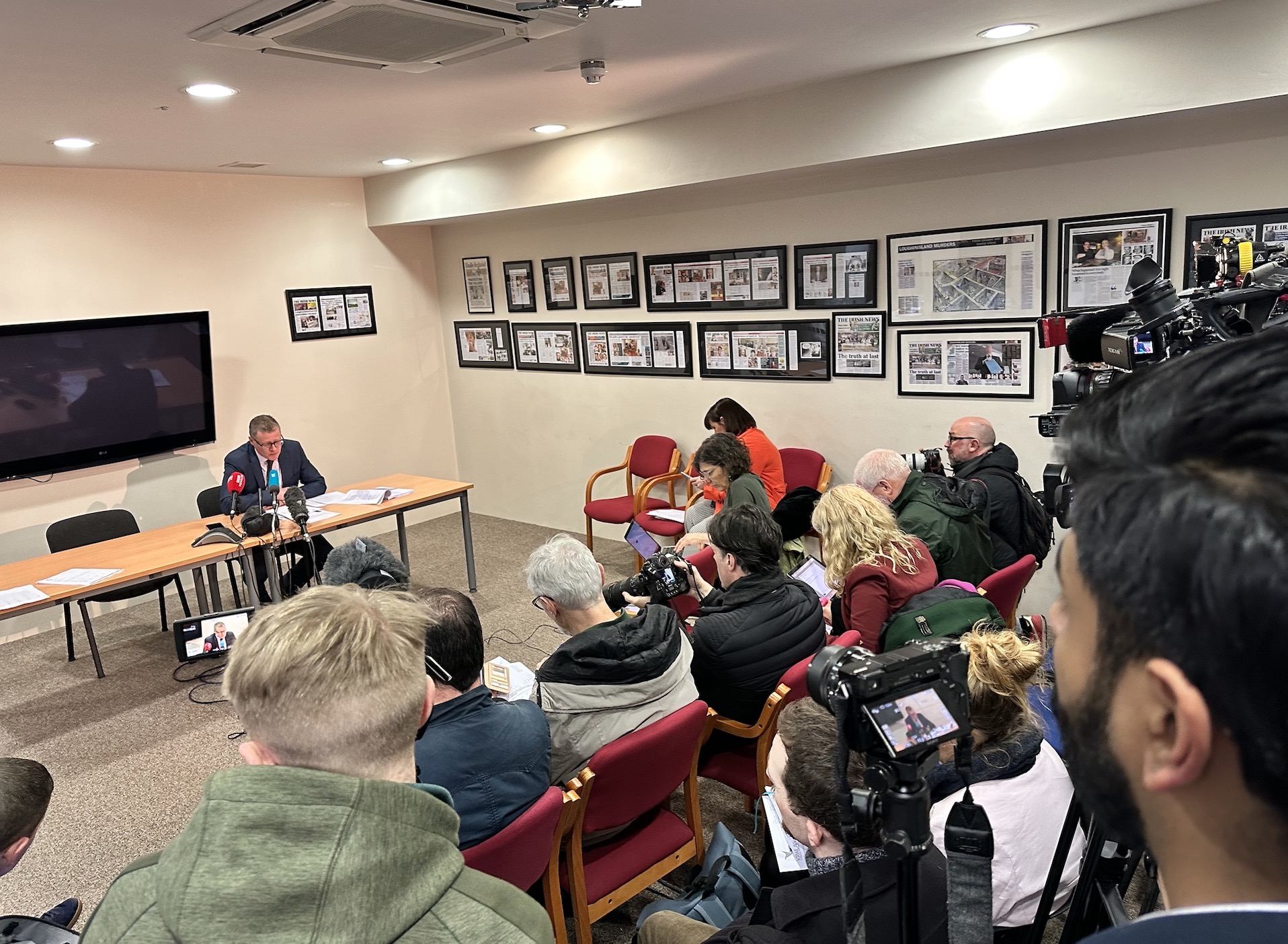KRW LAW on Operation Kenova report 8.3.24
Today marks the end of a lengthy policing and legal odyssey for many families of victims and survivors of “The Stakeknife Project.”
Whether or not it points the way for a further journey remains to be seen.
In 2016 George Hamilton, the Chief Constable of PSNI invited Jon Boutcher to head up a new investigation into the terrorist and criminal activities of the alleged State agent known as “Stakeknife”. In many ways this was a default investigation that was never meant to be. It was borne out of the collective legal outworkings of many components of the justice system including the CCRC, the PPS, PONI, PSNI, HET together with the work of John Stevens.
In 2008 the Court of Appeal acquitted a number of persons previously convicted for offences connected to the abduction and detention of a self confessed agent, Sandy Lynch. Freddie Scappaticci was present but eluded prosecution. At the end of that judgment the Court said it expected, “An investigation into whether or not there were any breaches of the law of Northern Ireland.” The legal unravelling of those throw away comments together with the outworkings of an earlier perjury complaint allegation partly formed the origin of todays Report.
The person at the centre of both sets of litigation was a West Belfast bricklayer and former senior member of the Internal Security Unit of IRA. His name was Fred Scappaticci. For over 20 years now he has been openly reported as the epicentre of British Military Intelligence penetration of IRA during the Conflict.
As a preliminary, we want to commend the former head of the Kenova investigation, Jon Boutcher and his team for their work over the past 7 years. On a personal note, I have never encountered such intensive levels of interfacing between police, families, witnesses and many others. The engagement was in complete contrast to the wholesale communication deficit between the RUC and families of victims during the Conflict.
We represent a wide constituency of clients invested in todays Report. They range from families of murder victims, people killed as alleged informants or touts through to survivors of IRA Internal Security Unit interrogations and others.
All of those engaged in the Kenova investigation process have had different levels of expectation. For some, the engagement was about getting as much information as possible on the circumstances surrounding the killing of a family member with little or no interest in a criminal case. Many others want to see criminal prosecutions.
For the former both this Report and the further family bespoke reports due to follow, does what it says on the tin. It has delivered. The level of information and detail imparted meets expectations.
For the latter it is a case of what might have been and a halfway house on justice. We say this because given the sheer volume of evidence and information, albeit much of which is of an intelligence nature, there was an expectation the PPS could direct prosecutions against those involved in or directing the killings.
That disappointment has been compounded by the specific failure to direct prosecutions against former members of the Security and Intelligence services. Families know or have a suspicion who was involved in the IRA killing of their family member. They were not particularly interested in prosecutions against IRA foot soldiers who were ordered, directly or indirectly to kill. Their focus has been the identity of those “handlers” and others who facilitated and protected Fred Scappaticci and possibly others from detection.
Some families rightly reserve their annoyance for the Public Prosecution Service. Kenova investigators were faced with logistical problems in terms of access to evidence which ought to have been retained but was in fact destroyed or lost. This is particularly so when you look at the records of the Task Coordinating Group (TCG). The industrial destruction of TCG – based material and other records served to undermine the work of Kenova and create further delay. This systemic culling of material chimes with the obstacles put in place of Sir John Stevens whenever he commenced his work in investigating Loyalist – State collusion in the 1990’s.
MI5 and other authorities based in Whitehall fortunately retained many records, which had they not been made available, would have meant Kenova concluding a number of years ago.
Todays report presents as a damning indictment of the State. The staggering takeaway message is that the State could have intervened to save lives. That this didn’t happen is legally and morally reprehensible. The findings point to the existence of a macabre joint enterprise between Force Researching Unit (FRU), the TCG and those who fired the shots. We are left with the horrendous conclusion that both State and IRA were co conspirators in the murder of its citizens.
This ought to present as a strong riposte to the naysayers critical of Kenova for the £40million price tag and time expended in reaching this point today. There would have been no cost at all had the State not operated an utterly dysfunctional policing system in the oversight of the Stakeknife Project. Any blaming for the cost of this inquiry rests with the British Government. There is an obvious parallel with other Troubles related investigations. You can never put a price on the cost of exposing the Truth in circumstances where vast cost has been deployed in suppressing the Truth.
The decision not to name Fred Scappaticci as the agent Stateknife has been difficult for many to accept. The legal and technical rationale for doing so will be lost on many people particularly next of kin of those murdered. We are encouraged by the prospect of a changed position at some stage in the near future. Given the very specific nature of the Terms of Reference it is annoying that Fred Scappaticci cannot be named as the agent Stakeknife. The Report makes it very clear, by inference or otherwise, that Scappaticci was the agent Stakeknife but for many its important to see his name “go up in lights” as Stakeknife.
For many the Kenova engagement has been all about finding out whether or not a relative was a “tout”. At best this absence has been underwhelming and at worst it has been re traumatizing. From a legal perspective we can appreciate the Article 2 ECHR rights of individuals not to be named. We say there is an overwhelming case to be made for a departure from NCND. These are deeply sensitive matters and has left a number of families in limbo. Families will be greatly encouraged by todays strong recommendation for a comprehensive review of NCND (Neither Confirm Nor Deny).
The findings in todays report make the PPS decision not to prosecute anyone all the more depressing. Many hoped that someone from the Security Force Intelligence constituency would be prosecuted for perverting the course of justice, conspiracy to murder and other offences. Todays findings only serve to compound frustration to address this glaring justice deficit. We have requested reviews in a number of cases and are now at the point of litigation against the PPS on failure to look at overarching criminal corporate failings. We say Government and relevant agencies had a statutory obligation under Health and Safety regulations to handle and oversee the deployment of intelligence but that didn’t happen here. Instead we have seen a disproportionate focus on specific ex-FRU individuals. Whenever handlers received intelligence information that someone was abducted and their life put at risk it was reported to their Senior Commanding Officers within FRU, TCG and elsewhere. Regrettably that intelligence was not acted upon. To address this injustice we have today commenced a Judicial Review legal action against the PPS in the case of Anthony Braniff.
To that end Kenova replicates the outworkings of John Stevens Reports from over 20 years ago. Some of his recommendations on prosecutions in connection with Loyalist State collusion were similarly rejected by the DPP. There was never any realistic prospect of having ex members of the Security Forces in a Belfast dock. Anyone so prosecuted had a ready made defence of, “Obeying orders from above.” The moment you prosecute you interfere with a delicate post Conflict politico – legal Eco system which opens up the road to Whitehall. Over a decade ago the former Prime Minister David Cameron spoke about men in dark suits in Whitehall preventing him from giving the Finucane family an inquiry. Those very same suits are lurking in the shadows here.
And so to the legacy of Kenova. The report calls for apologies all round. Respectfully, this does not really cut it for some families. In many ways it represents a soft landing. As an alternative we say the report sign posts a way forward for a full Public Inquiry into State penetration of PIRA ISU during the Conflict. The Terms of Reference for Kenova were deliberately Freddie Scappaticci – centric to the exclusion of investigation into other alleged agents working within that Unit. It is over simplistic and naive to assume that Fred Scappaticci operated as a lone agent. It is misleading to assume that he presents as the apex of British State collusion inside the IRA. Many of the cases investigated by Kenova do not feature Fred Scappaticci at all. He was not the only “Stakeknife”. In this respect Section 67 of the Report is instructive and enlightening.
Todays Report does not end the “Stakeknife” saga. On the contrary, it signposts the need for further probing. Last week the Chief Constable and a High Court Judge called for a public inquiry into collusion allegations surrounding the 1997 murder of GAA Official Sean Brown. In terms of consistency and evidential justification we say Kenova grounds the basis for a similar Public Inquiry into other “Stakeknives”.
The British Governments attempt to shut down on the spectre of other Kenova esque investigations does not necessarily serve to prevent a Public Inquiry because Inquiries under Section 1 of the Inquiries Act are exempt from the Legacy Act.
The content of todays Report today presents an overwhelming endorsement for the need to have an Inquiry. If this were in middle England, there would be no debate about that. Unfortunately when it comes to Conflict – related incidents there is a depressingly familiar wholesale amnesia.
On a final note we commend all of those who invested support in this investigation and had the bravery to step forward and have their voice heard. The stigma for the tout or informant runs very deep in Irish history. That stigma extends to next of kin and the next generation after that. Indeed, if proof were needed of that we need only look around this room today. Families still feel uncomfortable being in the public domain. These families were very much last in the queue when it came to justice and truth recovery. None of them had the benefit of political or other support to highlight their cases. As a post script I think its important to record that without the input and engagement from families and others the effectiveness of Kenova as an investigation would have been substantially diluted.
Todays Report puts to bed the myth that agents like Freddie Scappaticci saved lives; this key finding also serves to expose the lies about the deceased Loyalist agent Brian Nelson and the claim that he saved, “hundreds of lives.”
Equally significant is the conclusion the PPS failed to properly resource Legacy investigations. The decision making on Fred Scappaticci timed out when he died and with that went a massive opportunity to add to the work of Kenova and have an examination of this criminal dysfunctionality played out in a Belfast Court
There is a real irony then that these Conflict – bereaved and marginalized families were able to contribute so much to todays landmark findings of State sanctioned complicity in the murder of its own citizens.



